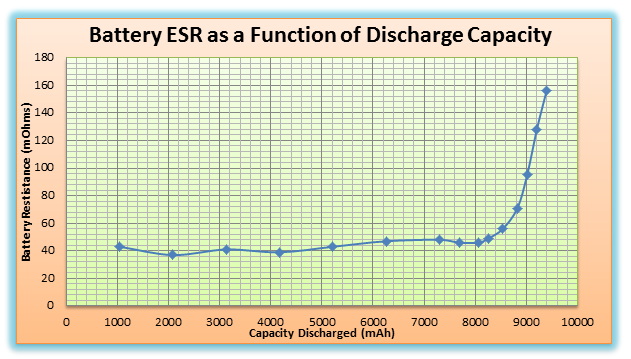Just for the record, here are some of my findings. They are not directly measured, but inferred by the voltage readings inside of the laptop while charging and discharging... (if your laptop doesn't display this, try BatteryInfoView, which I found to be a pretty handy free tool...)
I got my first used laptop, a Thinkpad T61, back in February 2012. It came with a battery which at the time still held up for about 90 minutes, but lost capacity rapidly. On March 21th, the calibration gave a reading of about 25% capacity left, however, some more capacity was hidden in the lower part of the curve which couldn't be used anymore because the voltage reached 10.24 V at about 50% discharge, at which point the calibration process switched to recharging it. That battery (a 6-cell one with 10.8 V, thus we have three cells in series and 2 in parallel) had a short-term resistance of 325 mOhms, and a long-term one of 510 mOhms. The short-term is comparing the readings directly before and after the switch from discharge to recharge, and the long-term one is at a somewhat higher, but consistent part of the curve. This would put each individual cell at 217 and 340 mOhms, respectively. This battery degraded further pretty fast... on October 19th, it had only 0.8 Ah left, which is 15% of the original capacity, and the long-term resistance per cell had risen to 512 mOhms according to my calculations. We recycled the battery after that.
In fact, I had already bought a new replacement battery in April 2012, which was first calibrated with the data recorded in November 2012, and then it had about 98 mOhm per cell at a capacity of 97% of nominal. This was at 87 cycles (where a Lenovo cycles actually is only 70% of total capacity).
Further results were (resistance is per cell, not for the pack):
130 mOhms long-term at 94% of remaining capacity on April 5th, 2013, after 125 cycles;
147 mOhms long-term at 93% of remaining capacity on January 5th, 2014, after 240 cycles;
148 mOhms long-term at 91% of remaining capacity on August 8th, 2014, after 311 cycles;
(The next calibration data from April 2015 was lost)
Right now we are sitting at 207 mOhms long-term and 150 short-term at about 85% of remaining capacity, after 428 cycles. I expect the battery to be useful until about 500 cycles which would be reached sometimes next summer.
However, the laptop is now a different one, a used T60 since the T61's display was ruined on a ride with an e-bike. With the T60, I got a 9-cell battery which seems to be pretty good for its age... it's from 2009, but after two calibrations it still shows 90% of original capacity, at an internal resistance of only 100 mOhms for the pack... since these are 3 cells in parallel and 3 in series, this would also be the internal resistance of each individual cell in average.
Before that I bought a cheap Chinese spare pack using 12 cells, but still having an internal resistance of about 250 mOhms, which would put each cell at 167 mOhms, although the cells do deliver their rated capacity of 2200 mAh each. I'm in doubt if all of that comes from the cells, however... some of it may also be produced by resistance in the wiring in the pack itself or the switching transistors, since they are the part that gets very hot, much hotter than the cells, if the battery gets a high load.
In between the T61 and the T60, I had a used ASUS laptop, but sadly it got stolen only a week after I bought it. Its battery, however, also had an internal resistance of 250 mOhms, but it was a 6-cell battery like the one I got for the T61... well, not quite like it since from the discharge curve it seems like it used the same cells as used in the Chinese spare pack for the T60, and it also used 2200 mAh cells unlike the 2600 mAh ones used by Lenovo for their genuine packs. The pack showed a "wear level" according to BatteryInfoView (Asus doesn't supply any software of their own to check this) of about 85-86%, and the internal resistance of each cell would then be roughly 167 mOhms. The number of cycles is unknown (BatteryInfoView doesn't even manage to display it for the T60 and T61 where it gets correctly displayed by Lenovo's own software, and it also showed 0 on the ASUS laptop).
So much for the results I got. For the Lenovo packs I would say that they cross the line of getting not so useful anymore at an internal resistance of about 200-300 mOhms per cell (short-term / long-term). After all, they have to deliver up to about 55 Watts in a T60 or T61 laptop when fully loaded, like playing DVD's with additional devices hanging on the USB ports.
 ? I had a control Panasonic battery that isn't very old and at 4.2V it had 0.31ohms internal resistance. I wanted to do this test to find out how used they are, I saw they are supposed to be charged at 4.35V to get their full capacity(when new) but it will be ok for me even charged at 4.2. This a a picture with one of them
? I had a control Panasonic battery that isn't very old and at 4.2V it had 0.31ohms internal resistance. I wanted to do this test to find out how used they are, I saw they are supposed to be charged at 4.35V to get their full capacity(when new) but it will be ok for me even charged at 4.2. This a a picture with one of them
 [/URL][/IMG]
[/URL][/IMG]


